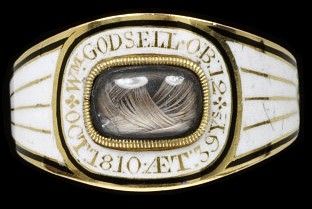Mourning Jewelry: creepy or cool?
- Heather Moll
- Jun 12, 2022
- 3 min read
I feature a piece of jewelry in every full-length Regency novel I write. Usually, jewelry is associated with glamor and wealth, or is a romantic gift. But what about jewlery as mementos of beloved people who are no longer with us? When you see a piece of mourning jewelry, do you think it's morbid? Many do, and that’s even before we get into the use of hair. But if you’re shuddering, stick with me because there’s a lot to appreciate in these pieces even if you would never wear one.

We have to separate ourselves from our modern ideas of how to memorialize people. Now, a grieving mother might post on Facebook on her child’s birthday, or a spouse who lost their significant other will share pics on Instagram of their last anniversary. We grieve and remember people differently than the Georgians, and the truth is that they faced death more often than we do.
We have a camera on a device that we always carry with us. Few days go by where I don’t take a picture of my child, and I have pics of my husband and parents that are only a few months old. I could easily view years’ worth of pictures of all of my family and closest friends.
But can you imagine not being able to remember what your loved one looked like and not have a picture to remind you? We have videos or old voicemails to hear their voices, but people in Regency England had no way to ever hear their loved ones voices. Not everyone sat for a portrait, and even the most wealthy might have only sat for a few in their lifetime. So, without an image to remember your loved one, without a social platform to share your memories, what is another way to keep their memory alive?
The custom of wearing jewelry to commemorate a death has been around for centuries. Memorial rings were the most common—so, of course, I didn’t pick rings to use in An Affectionate Heart. It was not only fashionable in the Georgian era to wear mourning jewelry, but it was expected. It was so common, in fact, that people would put provisions in their will for the making of mourning jewelry for their nearest and dearest.
Common memorial rings were a gold and black enamel band with the name, the date of death, and the age of death. This could be on the outside or the inside of the band. Sometimes they were larger with an inscription on the face. In An Affectionate Heart, the two pieces say, “Not Lost But Gone Before” and “In Death Lamented as in Life Beloved”.
In some of the pictures you can see the letters OB before a date and AET before a number. These are latin abbreviations; ob stands for obitus (death) and aet is short for aetatis or aetas (years or time of life). White enamel often symbolized a lost child or that the deceased was unmarried.
Large pieces such as brooches and lockets had classical imagery such as weeping willows and urns. Some of these designs were chosen from a catalog, and others were custom made with imagery that might have been more personal. A ship might have meant a sailor lost at sea, a weeping willow symbolized sorrow. Pearl decorations often indicated tears of grief.

So, are we gonna talk about the hair? This tends to make people cringe. Sentimental hair jewelry took off in the Victorian era, but it was poplar with the Georgians too. Still, I didn’t use it as bracelets or necklaces in An Affectionate Heart. At this time, hair was more often set under glass or put in a locket. The styling of the plaiting was another thing that could have been picked from a catalog.
Are you thinking, “Eww, who would keep hair?” Remember what we said about no pictures. Did you save a curl of your kids’ hair from their first hair cut? Do you know someone who saved a lock of their spouse’s hair when they died? I’ll bet a few of you even saved your kid’s first baby tooth. Hair is lasting, and it’s a tangible reminder of a loved one. The mourning ring with hair set in it that you disdain as creepy was someone’s treasured remembrance.
That’s not to say that I would want to own someone’s else’s mourning jewelry. But I can I understand why someone would want mourning jewelry to remind them of someone who meant something to them, and even find beauty in it?
In An Affectionate Heart, both Darcy and Elizabeth have a piece of mourning jewelry, and being able to hold and wear these pieces are a part of the grieving process. It's a way for them to bond and a way to keep close the memory of someone who is gone.
What do you think of these pieces? Even if you wouldn't wear one yourself, can you appreciate them a little more?






